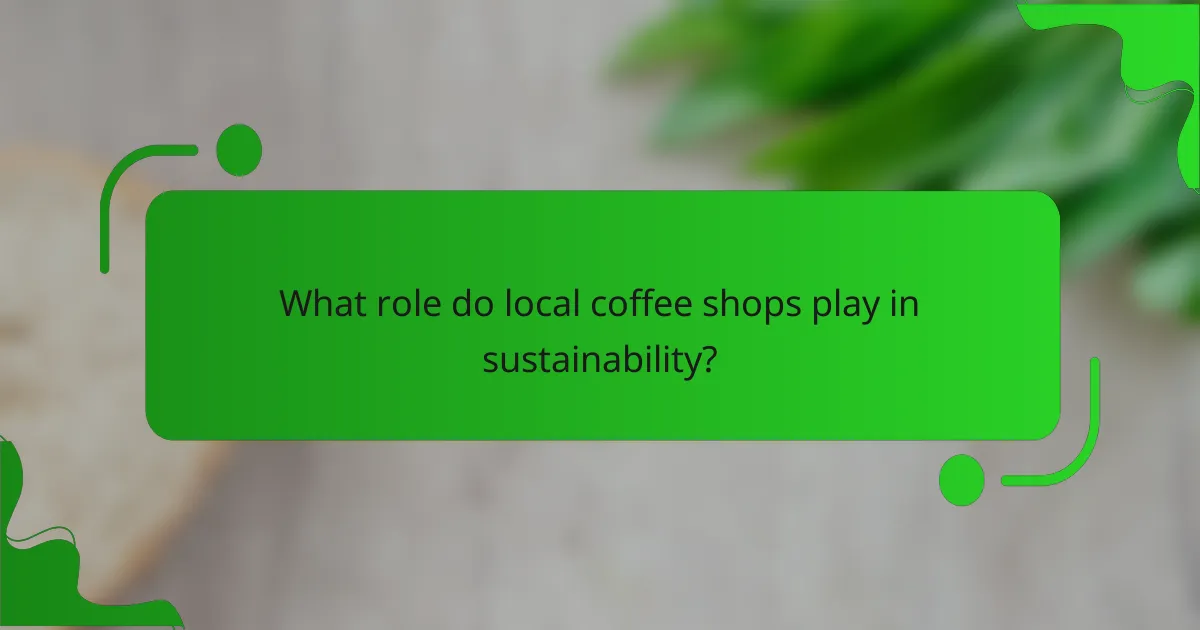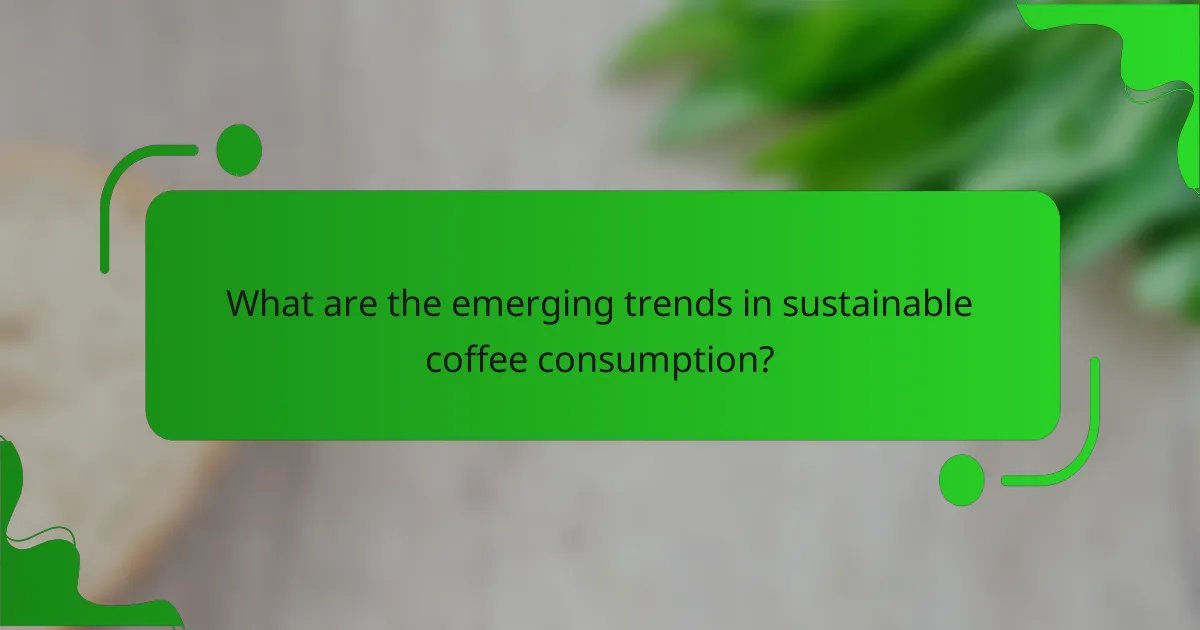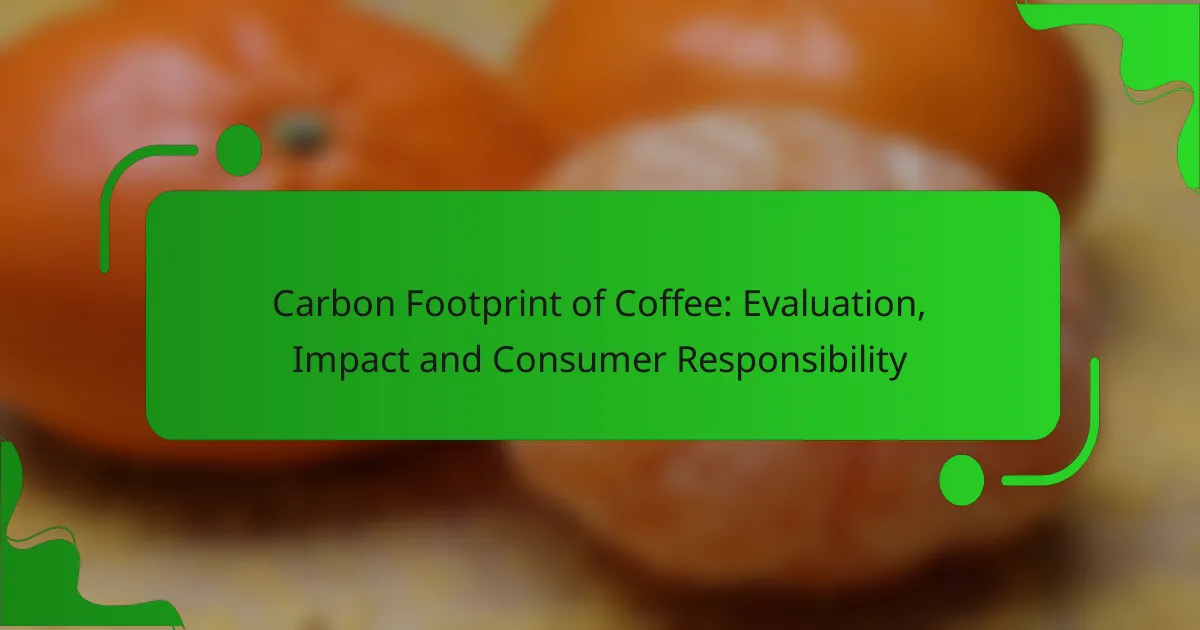The carbon footprint of coffee production encompasses the greenhouse gas emissions generated from cultivation to consumption, significantly impacting climate change. By making informed choices, such as selecting local and sustainable options, consumers can play a vital role in reducing these emissions. Simple actions, like using reusable cups and supporting fair-trade practices, can collectively lead to a more sustainable coffee culture.

How can consumers reduce the carbon footprint of coffee in Los Angeles?
Consumers in Los Angeles can significantly lower the carbon footprint of their coffee by making informed choices about sourcing, consumption, and waste. Simple actions like selecting local roasters, choosing organic and fair-trade options, using reusable cups, and engaging in community events can collectively make a positive impact.
Choosing local coffee roasters
Selecting local coffee roasters helps reduce transportation emissions associated with coffee delivery. By sourcing beans from nearby roasters, consumers support local economies and often enjoy fresher products. Look for roasters within a few miles of your home or workplace to maximize these benefits.
Additionally, local roasters may prioritize sustainable practices, such as sourcing beans from environmentally conscious farms. Researching their sourcing methods can provide insight into their overall carbon footprint.
Opting for organic and fair-trade coffee
Choosing organic and fair-trade coffee can significantly reduce environmental impact. Organic coffee is grown without synthetic pesticides and fertilizers, promoting healthier ecosystems. Fair-trade certification ensures that farmers receive fair compensation, encouraging sustainable farming practices.
Look for brands that are certified organic and fair-trade, as these labels indicate a commitment to environmentally friendly and socially responsible practices. This choice not only supports the planet but also helps improve the livelihoods of coffee growers.
Using reusable coffee cups
Using reusable coffee cups is a straightforward way to minimize waste associated with single-use cups, which contribute to landfill overflow and greenhouse gas emissions. Many coffee shops in Los Angeles offer discounts for customers who bring their own cups, making it a cost-effective choice as well.
Consider investing in a high-quality, insulated cup that keeps beverages hot or cold for longer. This not only reduces waste but also enhances your coffee-drinking experience.
Participating in community coffee events
Engaging in community coffee events fosters connections with local roasters and promotes sustainable practices. Events such as coffee tastings, workshops, and sustainability forums often emphasize eco-friendly brewing methods and sourcing practices.
Check local listings or social media for upcoming events in Los Angeles. Participating can deepen your understanding of coffee’s environmental impact and inspire others to make responsible choices.

What is the carbon footprint of coffee production?
The carbon footprint of coffee production refers to the total greenhouse gas emissions generated throughout the coffee supply chain, from cultivation to consumption. This footprint can significantly impact climate change, making it crucial for consumers and producers to understand and mitigate these emissions.
Average emissions per cup of coffee
On average, the carbon emissions associated with a single cup of coffee range from approximately 100 to 200 grams of CO2 equivalent. This figure can vary based on factors such as brewing method, type of coffee bean, and transportation distances.
For instance, espresso typically has a lower carbon footprint compared to drip coffee due to its concentrated brewing process. However, specialty coffees that require extensive processing may have higher emissions.
Factors influencing carbon emissions
Several key factors influence the carbon emissions of coffee production, including agricultural practices, processing methods, and transportation. Sustainable farming techniques, such as shade-grown coffee, can reduce emissions by promoting biodiversity and soil health.
Additionally, the processing stage—whether wet or dry—can affect emissions. Wet processing generally requires more water and energy, leading to higher carbon outputs. Finally, transportation logistics, including the distance traveled and the mode of transport, play a significant role in the overall carbon footprint.

How does coffee cultivation impact the environment?
Coffee cultivation significantly impacts the environment through deforestation, habitat loss, and high water usage. These factors contribute to biodiversity loss and strain local water resources, making sustainable practices essential for minimizing environmental harm.
Deforestation and habitat loss
Coffee farming often leads to deforestation, particularly in tropical regions where coffee is predominantly grown. Forests are cleared to create plantations, resulting in the loss of biodiversity and disruption of ecosystems. This not only affects wildlife habitats but also contributes to climate change by reducing carbon sequestration.
To mitigate these effects, some coffee producers are adopting agroforestry practices, which integrate coffee cultivation with tree planting. This approach helps preserve forest cover, supports wildlife, and enhances soil health while still allowing for coffee production.
Water usage in coffee farming
Water usage in coffee farming is a critical environmental concern, as coffee plants require substantial amounts of water for optimal growth. On average, it takes about 140 liters of water to produce just one cup of coffee, which can strain local water supplies, especially in regions facing water scarcity.
Farmers can reduce water consumption by implementing efficient irrigation techniques, such as drip irrigation, and by selecting coffee varieties that are more drought-resistant. Consumers can also support sustainable coffee brands that prioritize water conservation and responsible farming practices.

What are the benefits of sustainable coffee practices?
Sustainable coffee practices offer significant environmental and social benefits, including improved ecosystem health and better livelihoods for farmers. By adopting these practices, consumers can contribute to a more resilient coffee supply chain.
Improved soil health
Sustainable coffee farming techniques, such as agroforestry and organic farming, enhance soil health by promoting biodiversity and reducing chemical inputs. These methods increase organic matter in the soil, which improves water retention and nutrient availability.
Farmers can implement practices like cover cropping and composting to further enrich the soil. These techniques not only boost coffee yields but also reduce erosion and degradation, leading to more sustainable land use over time.
Enhanced biodiversity
By prioritizing sustainable methods, coffee producers can protect and promote biodiversity in their farming systems. Planting shade trees and maintaining natural habitats around coffee farms support a variety of species, which can help control pests and diseases naturally.
Encouraging biodiversity also contributes to the resilience of coffee ecosystems against climate change. Consumers can support this by choosing coffee brands that prioritize sustainable sourcing and certifications, such as Fair Trade or Rainforest Alliance.

How can consumers make informed coffee choices?
Consumers can make informed coffee choices by understanding product labels and researching brands’ sustainability practices. This knowledge helps in selecting coffee that aligns with personal values regarding environmental impact and ethical sourcing.
Understanding coffee labels
Reading coffee labels is essential for making informed decisions. Look for certifications such as Fair Trade, Rainforest Alliance, or USDA Organic, which indicate adherence to specific environmental and social standards. These labels often reflect a commitment to sustainable farming practices and fair wages for farmers.
Additionally, pay attention to the origin of the coffee. Single-origin coffees often provide insights into the farming practices and environmental conditions of that region. For example, coffees from regions with established sustainability programs may have a lower carbon footprint.
Researching brands’ sustainability practices
Investigating a brand’s sustainability practices can reveal their commitment to reducing environmental impact. Many brands publish sustainability reports or information on their websites detailing their efforts in sourcing, production, and packaging. Look for brands that prioritize eco-friendly practices, such as using recyclable materials or supporting reforestation initiatives.
Consider reaching out to brands directly with questions about their sourcing and sustainability efforts. Engaging with companies can provide clarity on their practices and help consumers make choices that align with their values. Additionally, online reviews and third-party assessments can offer insights into a brand’s reputation regarding sustainability.

What role do local coffee shops play in sustainability?
Local coffee shops play a significant role in promoting sustainability by fostering community engagement and implementing eco-friendly practices. Their operations can reduce carbon footprints while supporting local economies and encouraging environmentally responsible consumer behavior.
Supporting local economies
Local coffee shops contribute to sustainability by sourcing their beans and other products from nearby farmers and suppliers. This practice not only supports local economies but also reduces transportation emissions associated with long-distance shipping.
By prioritizing local partnerships, these shops help create jobs and stimulate economic growth within their communities. Consumers can feel good knowing their purchases directly benefit local producers and businesses.
Implementing eco-friendly practices
Many local coffee shops adopt eco-friendly practices such as using biodegradable cups, recycling, and composting coffee grounds. These initiatives help minimize waste and lower their overall environmental impact.
Additionally, some shops offer discounts for customers who bring their own reusable cups, encouraging sustainable behavior among patrons. By integrating these practices, local coffee shops can significantly reduce their carbon footprints while promoting a culture of sustainability within their communities.

What are the emerging trends in sustainable coffee consumption?
Emerging trends in sustainable coffee consumption focus on reducing environmental impact while meeting consumer demand for ethical products. This includes a shift towards eco-friendly practices, carbon-neutral brands, and increased transparency in sourcing and production.
Growth of carbon-neutral coffee brands
Carbon-neutral coffee brands are gaining traction as consumers become more environmentally conscious. These brands typically offset their carbon emissions through various means, such as investing in renewable energy or supporting reforestation projects.
Many companies are adopting certifications like CarbonNeutral® or similar standards to validate their claims. This not only appeals to eco-minded consumers but also encourages other brands to adopt sustainable practices.
When choosing carbon-neutral coffee, look for brands that provide clear information about their offset strategies and the impact of their initiatives. Popular options include brands that partner with environmental organizations or those that utilize sustainable farming methods to minimize their carbon footprint.



